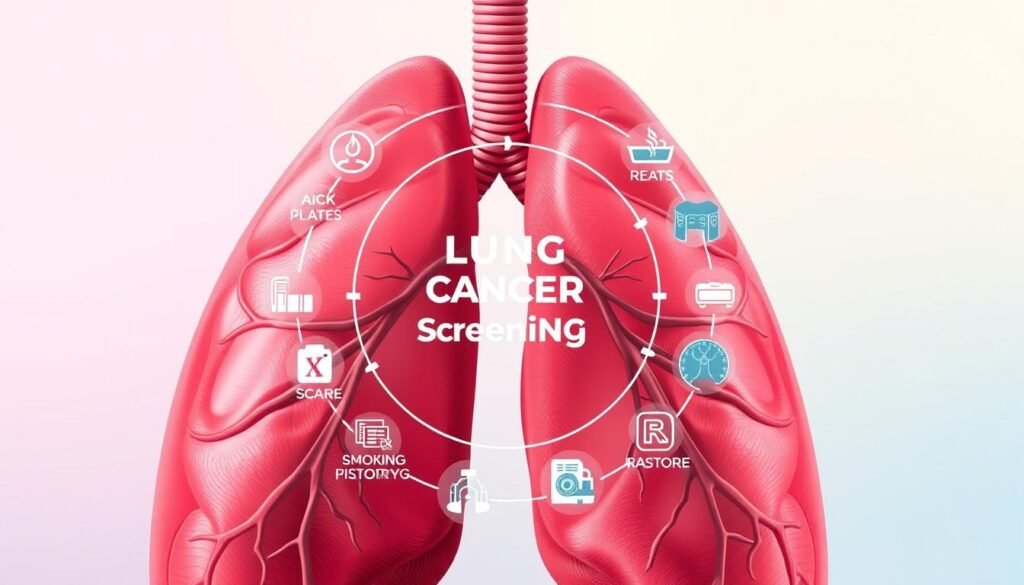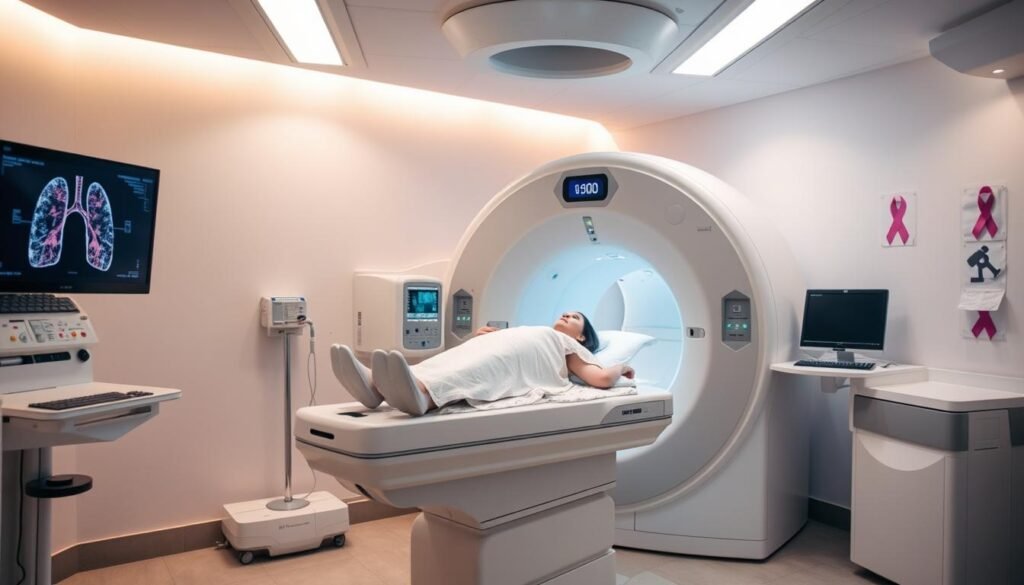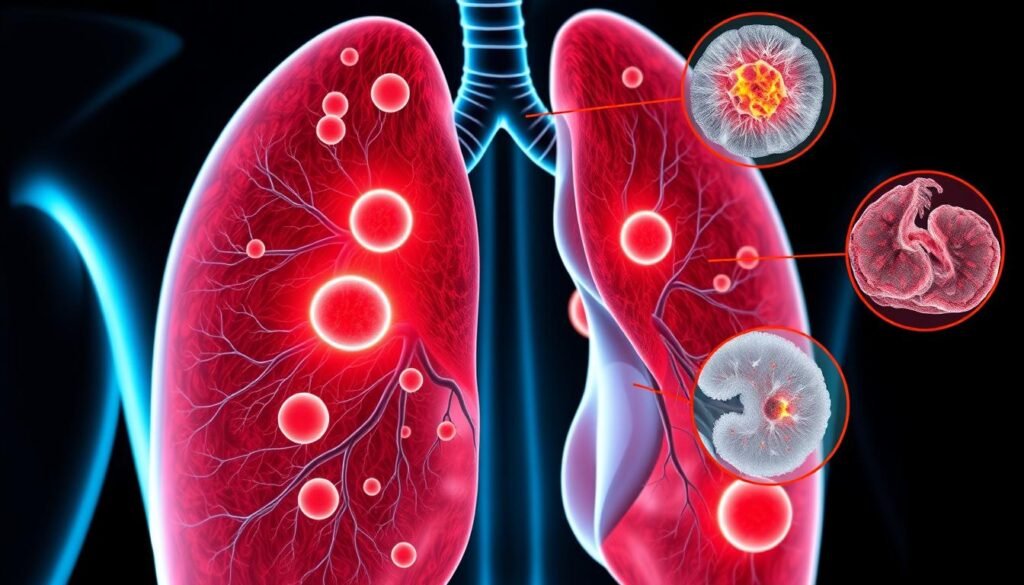Lung cancer leads in cancer deaths in the United States, making up about 25% of all cancer losses. This fact shows why finding it early matters so much. Thanks to low-dose computed tomography (LDCT), spotting lung cancer early has gotten easier, which helps high-risk people a lot. The American Cancer Society suggests yearly checks for those 50 to 80 who smoke or did smoke a lot, around a 20 pack-year history. This goes to show how key screenings are in saving lives.
LDCT lets doctors see possible cancer spots in the lungs but with less radiation than normal CT scans. As how we check for lung cancer shifts, it’s crucial for those at risk to know the pros and cons. This article will go over these points, highlighting how taking action early can help fight CT lung cancer better.
Key Takeaways
- Lung cancer is the second most common cancer and the leading cause of cancer death in the U.S.
- Annual low-dose CT scans are recommended for high-risk individuals aged 50 to 80 years.
- Early detection through LDCT significantly increases five-year survival rates.
- Screening results must be interpreted with care to avoid unnecessary anxiety.
- Smoking cessation support is vital to reducing lung cancer risk.
Understanding Lung Cancer
Lung cancer comes in two main types: non-small cell (NSCLC) and small cell (SCLC). Knowing the difference is key for treatment. Certain risk factors can make people more likely to get lung cancer.
Smoking is the top risk factor for lung cancer. Both people who smoke now or did before are at risk. Exposures to radon, asbestos, and polluted air are also dangerous. So is having a family history of lung cancer. Knowing these lung cancer risk factors matters for your health.
It’s crucial to know the signs of lung cancer early on. Look out for symptoms like a bad cough, coughing up blood, or chest pain. Sometimes, these signs are overlooked as minor health issues. This can lead to a late diagnosis. If you have these symptoms and risk factors, see a doctor right away. Learn more about lung cancer diagnosis at this resource.
Importance of Early Detection
Early detection is key to fighting lung cancer. When found early, the chance of surviving lung cancer jumps to almost 60% over five years. This is particularly important for older adults and those who smoke.
Talking about screening options with healthcare providers is crucial for these high-risk groups.
There’s a big difference between those who could get screened for lung cancer and those who do it. Only 6% of eligible people get low-dose CT scans.
This is much lower than the 80% of women who get mammograms. It shows a big gap in awareness and action for lung cancer.
Not only does early detection improve survival rates, but it also opens the door for more effective treatments. Even though lung cancer causes the most cancer deaths in the U.S., most cases are found late.
This results in nearly 75% of patients not making it past five years after being diagnosed.
The National Lung Screening Trial shows low-dose CT scans can lower lung cancer deaths by 20-25% compared to regular chest x-rays. This emphasizes the importance of more people getting screened, especially those at high risk.
Raising awareness and making screenings more available are key. For example, Loyola Medicine offers accessible, cheap screenings. They aim to improve survival rates for those at high risk.
Lung Cancer Screening: An Overview
Lung cancer screening with low-dose CT scans is essential for early detection. It spots cancer before symptoms appear, greatly improving survival chances. Studies show that yearly low-dose CT scans can decrease lung cancer deaths by 20% in people 55 to 74 who are at high risk.
Research found a 24% reduction in death rates among heavy smokers. This highlights the need for specific screening plans for this group. The aim is to find cancer early when it’s easier to treat. Most cancers caught this way are still in the early stages.
It’s important to know the risks and limitations of lung cancer screening. Sometimes, screenings might show a 23.3% false-positive rate. Though false positives can cause stress and unnecessary tests, the advantage of finding cancer early outweighs these issues for those at risk.
The link between smoking and lung cancer is clear, calling for more education on screening. Smoking is behind 90% of lung cancer in men and 78% in women. Boosting awareness about low-dose CT scans is crucial.
| Screening Method | Mortality Reduction | False-Positive Rate | Early Detection |
|---|---|---|---|
| Low-Dose CT Scan | 20% – 24% reduction | 10.4% – 23.3% | 1.1% – 4.7% |
| Chest X-Ray | No reduction | 5% – 10% | Not effective |
Starting screening programs with low-dose CT scans is a beacon of hope against lung cancer, the top cancer killer in the US. Focusing on at-risk groups, healthcare experts can boost early detections. This could save many lives.
Who Should Get Screened for Lung Cancer
Getting checked for lung cancer early can make a big difference in treatment. It’s all about finding out who really needs to be screened. This is based on rules that focus on people at high risk. Catching the disease early can save lives.
Population Considered High Risk
People who are 50 to 80 years old and have smoked a lot are more likely to get lung cancer. If someone has smoked a pack a day for 20 years, they’re in this group. Since smoking causes most lung cancers, these folks need to watch out.
Age and Smoking History Factors
The age of a person matters when deciding on lung cancer checks. If you’re 50 to 80 and smoke or quit in the last 15 years, screening is key. But, if health problems could affect living long or handling surgery, screening might need a second thought. Also, if you’re over 81 or haven’t smoked in 15 years, yearly checks should stop.

| Criteria | Description |
|---|---|
| Age | 50 to 80 years old |
| Smoking History | 20 pack-year or more |
| Current Smoking Status | Current smoker or quit within the past 15 years |
| Health Limitations | No health issues limiting life expectancy or surgical candidacy |
| Screening Cessation Age | 81 years old or more, or 15 years smoke-free |
These criteria for lung cancer screening are used to correctly pick out and help those who will benefit the most from getting screened on their health journey.
CT Lung Cancer: Screening Guidelines
It’s very important to catch lung cancer early. This means people can get the help they need sooner. For those working in healthcare and patients, knowing the rules for CT scans for lung cancer is key. By following the most current advice, we can lessen the number of people who die from lung cancer.
Annual Low-Dose CT Scan Recommendations
The American Cancer Society suggests a yearly lung cancer check. This uses a low-dose CT scan for people who are 50 to 80 years old. They focus on people who have smoked a lot in the past. Being a heavy smoker means you’ve smoked a pack a day for 20 years. Or, it could also mean smoking two packs a day for 10 years.
Specific Criteria for Screening Eligibility
Those who smoke now or quit in the last 15 years should consider getting screened. The U.S. Preventive Services Task Force says this now applies to people aged 50 to 80. By updating their advice, many more people could get screened. This change could really help a lot of different people.
With screening, the goal is to gain the most while limiting risks. This means making sure the right doctors look at the CT scans. Following up properly is key to the success of lung cancer screening.
Benefits of Low-Dose CT Scans
Low-dose computed tomography (LDCT) is great in battling lung cancer. It shines by finding cancer early, which helps in treating it better.
Early Detection Advantages
LDCT screenings play a big role in catching lung cancer early. Screening with LDCT can lower lung cancer death risk by about 20%. The NELSON trial found it decreased lung cancer deaths by 33% for women and 24% for men. The American Cancer Society says using LDCT widely could save up to 60,000 lives each year in the U.S.
Impact on Treatment Outcomes
Finding cancer early with LDCT means better chances of beating it. It helps start treatment early, which helps people live longer. The National Lung Screening Trial showed LDCT screenings saved more lives than conventional chest X-rays.
Also, LDCT has much less radiation, about 1.4 millisieverts. That’s safer than regular CT scans, which have around 7 mSv of radiation. Since we normally get 3 to 5 mSv of radiation a year, LDCT is a good choice for those at high risk of lung cancer.

| Study | Reduction in Lung Cancer Deaths | Potential Lives Saved Annually |
|---|---|---|
| NELSON Trial | 33% (Women), 24% (Men) | – |
| American Cancer Society Estimate | – | 60,000 |
| National Lung Screening Trial | Significant reduction compared to chest X-ray | – |
| Risk Reduction via LDCT | 20% | – |
LDCT screenings do more than find cancer early. They change the game in treating lung cancer and play a key role in managing the disease.
Risks and Limitations of Lung Cancer Screening
Lung cancer screening has benefits, especially for people at high risk. However, it’s critical to know the risks of lung cancer screening. The main issues are false positives and radiation exposure. Both can affect a patient’s health.
False Positives and Overdiagnosis
False positives in lung cancer screenings are pretty common. Around 40% of low-dose CT scans might need more tests. But, more than 90% of these cases turn out to be non-cancerous. These results can cause a lot of stress for patients. They might also lead to unnecessary treatments like surgery or chemotherapy. Overdiagnosis is another problem. It means some detected lung cancers might not need treatment at all. This situation makes people worry about the harm from too much treatment. For detailed info, click this source.
Radiation Exposure Concerns
Radiation exposure is another big concern. Low-dose CT scans give about 2 millisieverts (mSv) of radiation. This is less than the 10 mSv from regular CT scans. Still, smaller doses can be risky if they happen often. Even low levels of radiation over time could raise cancer risks. Doctors say it’s vital to balance these risks with the benefits of screening.
| Risk Type | Description | Statistics |
|---|---|---|
| False Positives | Unnecessary positive results leading to anxiety and further testing | 40% of scans require additional investigation; 90% are not cancer |
| Overdiagnosis | Identifying cancers that would not require treatment | 1 in 5 detected cases may be overdiagnosed |
| Radiation Exposure | Potential health risks associated with radiation from scans | Approximately 2 mSv per low-dose CT scan |
Interpreting Lung Cancer Screening Results
After a low-dose CT scan, you’ll get your lung cancer screening results. These might show normal stuff or lung nodules. It’s key to know about these nodules. They can be nothing to worry about or something serious. Not all nodules are alarming, and some just need to be watched. It’s smart to talk over your results with your doctor. Together, you’ll plan what to do next and talk over any worries.
Understanding Lung Nodules
Nodules that are 5 mm or smaller are not usually worrying. But, bigger ones, especially in the lung’s upper parts, might be risky. The nodule’s size, how solid it is, where it is, and how fast it grows are important. They help tell if it could be cancer. Doctors use a system called Lung-RADS® for this. It helps them figure out the risk of cancer from low to high.
What to Expect After Screening
After your first screening, you might need more scans every year. Or, you might need other tests, depending on what they found. Doctors look at how big the nodule is and how fast it’s growing. They use this info to decide what tests you need. There are rules about who should get screened, based on age and if they’ve smoked. For more about how doctors check lung nodules, check out this study.

Lung Cancer Treatment Options
Lung cancer treatments depend on the cancer type, stage, and patient health. It can feel overwhelming, but knowing your options helps make better decisions. Early detection is crucial and can lead to a better outcome. Getting checked early can mean more effective treatment and a brighter outlook.
Treatment Modalities Available
There are different ways to treat lung cancer, such as:
- Surgery, especially for early non-small cell lung cancer, to remove the cancer
- Chemotherapy, which works for all types of lung cancer and is key for small cell lung cancer
- Radiation therapy, good for treating cancer in one spot, often used with chemotherapy
- Targeted therapies that attack cancer with special molecules
- Immunotherapy, boosting your own body to fight cancer
Treatments are personalized and may include a mix of these methods. For more on lung cancer treatments, check Mayo Clinic’s guide.
Prognosis Based on Early Detection
Finding lung cancer early greatly improves your chances. Early detection means surgery could completely remove the cancer. And, early-stage diagnoses have much better survival rates. Thanks to advanced imaging, spotting lung cancer early is getting easier. This leads to better outcomes and improved life quality.
Integrative Approach to Lung Cancer Screening
An integrative approach to lung cancer screening benefits both patients and doctors. It encourages patients to take part in decisions. Essential support services are included. This way, the screening process gets better, and patient-doctor relationships grow stronger.
The Role of Shared Decision-Making
Shared decision-making makes patients an active part of their screening. In a study with 505 patients, 88.1% used a decision aid. This lets people consider the pros and cons of lung cancer screening. It leads to informed choices, making them feel in charge of their health decisions.
Incorporating Smoking Cessation Support
Adding smoking cessation support to screening helps improve health outcomes. In the study, 61% of participants were smokers. Despite getting counseling, only 11% quit smoking. By meshing targeted smoking cessation programs with screening, we fight lung cancer risk better. Stopping tobacco use is key to lowering this risk, making it vital for lung cancer care.
| Patient Demographics | % of Total |
|---|---|
| African American | 57% |
| Caucasian | 30% |
| Hispanic | 13% |
| Asian | < 1% |
| Screening Outcomes | Statistic |
| Participants with LDCT | 96.1% |
| False Positive Rate | 10.7% |
| Patients with Lung Cancer Diagnosis | 3.2% |
Conclusion
Low-dose CT scans are key in finding lung cancer early. This kind of screening can greatly lower death rates from lung cancer among heavy smokers. Every day, 361 people in the U.S. die from lung cancer, so catching it early is crucial to save lives.
Even though screening costs about $542 million over 20 years, it’s worth it. It helps people live longer and get better treatment. Adults who smoked a lot between 50-80 should get screened, says the U.S. Preventive Services Task Force. Talking to a doctor about lung cancer screening can be a lifesaving part of your health care. To learn more, click on this link.
It’s important to weigh the pros and cons of lung cancer screening. Focusing on early detection can lower death rates and improve life quality for those at risk. This is a big step in the battle against lung cancer.